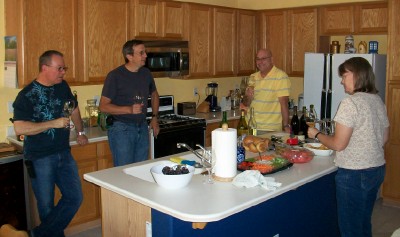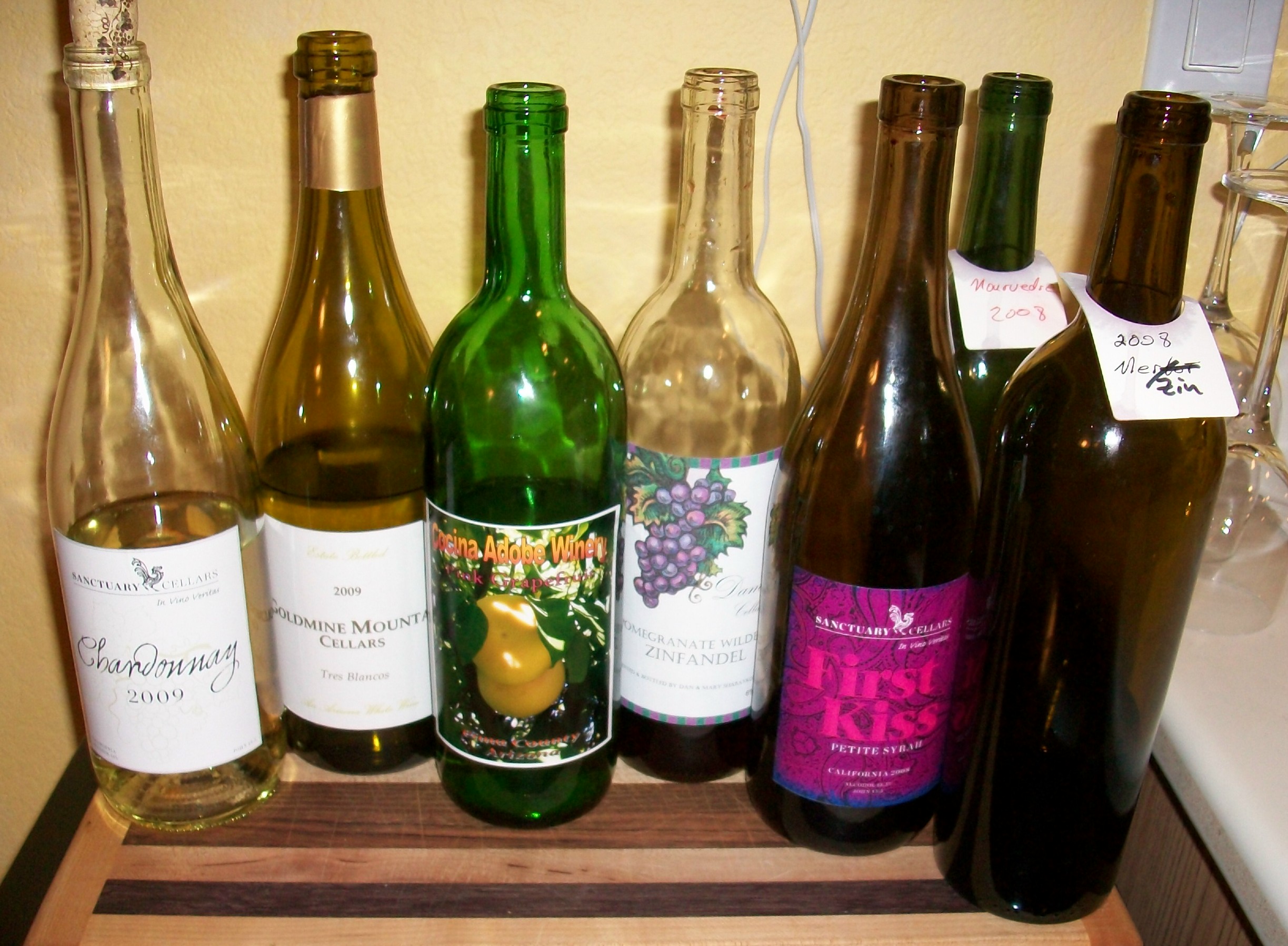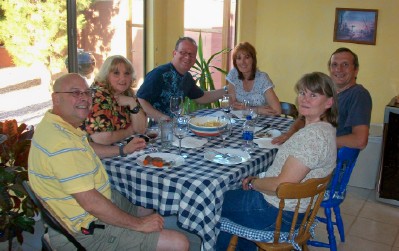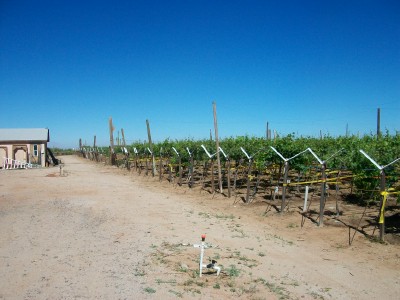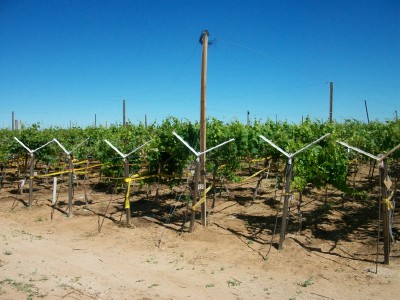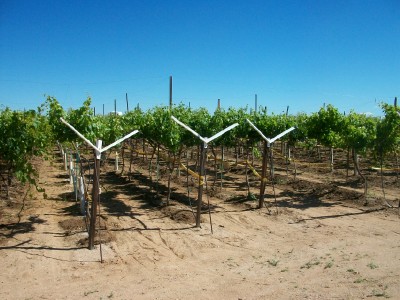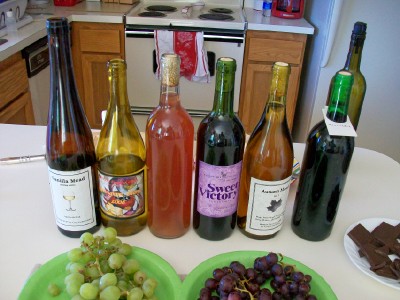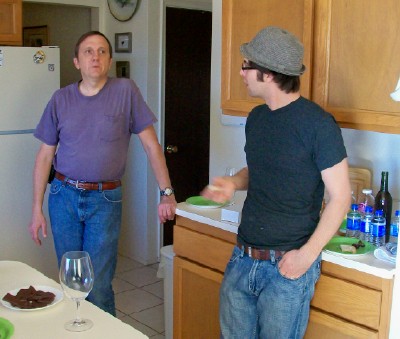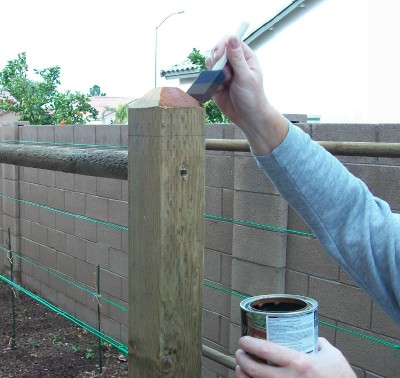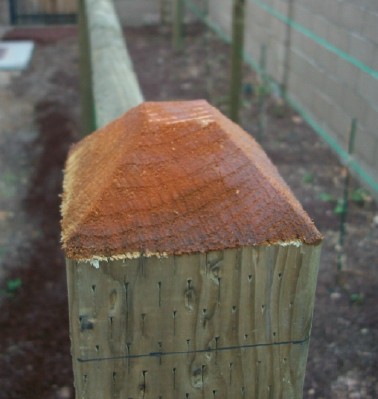GOLDMINE
MOUNTAIN
CELLARS WINE BLOG
2010 | |||||||||||||||||||||||||||||||
December 30
- I have a hard time passing up free fruit for wine making, especially
when it's really good fruit. Last summer while visiting Missouri I
noticed that the Concord vine my great grandmother planted long ago was
heavily laden with really ripe grapes. I harvested the fruit, froze it,
but only now found a convenient way to get it home to Arizona. 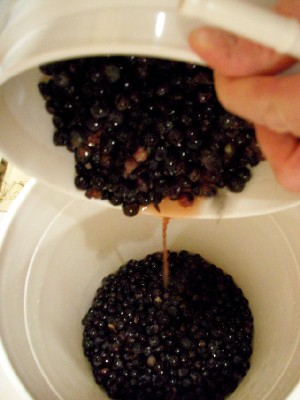 I got this batch started today, largely following Jack Keller's #2 recipe. December 7 - The next Arizona Wine Makers meeting is scheduled for December 18th. Please email me for information. December 1 - I love blending wine. Done right the finished wine can be better than the sum of its parts. A while back I worked up a large batch (by my standards) of Tempranillo from grapes I picked in southern Arizona. The majority of that wine is resting comfortably in a new Hungarian oak barrel, but I was left with two extra 3 gallon carboys. While this Tempranillo is great in most respects, it was just a little lacking in acidity which threw it off balance. I thought this would be a great opportunity to do some blending since I had a 3 gallon carboy of Merlot and another of Syrah, both from pasteurized juice. These wines were lacking in character and I was looking for the right time to blend them into something more interesting. I hadn't kept track of exactly how long I had been waiting though, and was surprised to find the last racking of each was early '09. Yes, that's right, these carboys hadn't gotten any attention in nearly two years. That's really not a problem in itself. Extended bulk aging provides many benefits. I was very concerned however as I pulled the stopper out of the Syrah and took a sample. On the nose and palate it was obviously a bit oxidized, and the color was slightly brickish. This was disconcerting to say the least, but I quickly drew off a sample of the Syrah and blended it with the Tempranillo; the results were fantastic! Any hint of oxidation is lost in the blended wine. I went ahead and racked both wines into a six gallon carboy and brought the SO2 levels up to around 80 ppm. I'll deal with the Merlot and second carboy of Tempranillo tomorrow. The first lesson here is to keep an eye on your SO2 levels as they can drop over time, leaving wine unprotected from oxidation and infection.. Airlocks can also dry out, but that wasn't the problem in this case. The second take away from this is what can be accomplished through blending. I wish I could have shared the samples with you. You can't always resolve a wine defect through blending, but in this case it really worked. The blended wine is definitely greater than the sum of its parts. November 17 - I got a call yesterday from someone who had seen my first article in Arizona Vines & Wines and has been having problems growing grapes in the desert. Out of twenty-four vines he planted in the spring, only seven had survived. We quickly identified the root cause of his problems... water, or more precisely, the lack thereof. His vines were getting flood irrigation every two weeks and someone was tasked with watering them by hand more frequently. As I've mentioned before, this seldom works out. In the hottest part of the summer vines need water every three or four days and the total weekly watering schedule needs to provide twenty-five to thirty-five gallons per vine per week. This is hard to deliver consistently when watering by hand. You may have heard that "grape vines don't like wet feet." This bit of conventional wisdom may hold true in other parts of the country, but here you're far better off to err on the side of too much water rather than too little. A truly excessive volume of water or daily waterings might foster root rot, but around here you're far more likely to have problems with too little water than too much. You may have also heard that "stressed vines make better wine." In a more moderate climate you might get away with reducing irrigation mid summer; this will undoubtedly cause some vines to fail, but most will survive. Here though that's just crazy. If you want grapes you must water your vines heavily and frequently. My watering schedule peaks between veraison and harvest with a total volume of about thirty gallons per week per vine, split up between waterings every three of four days (between thirteen and seventeen gallons at each watering). The leanest part of my watering schedule is during dormancy. From early December through mid February each vine gets just a few gallons per week. The goal here is just to keep the soil around the vines from drying out completely. I'm not even sure this is completely necessary. I gradually adjust the watering volume and frequency throughout the year between these two extremes. During rainy periods I may shut off the irrigation temporarily, but otherwise it's on all year. It's best to bump up the watering a bit right after bud break since water availability in the spring can influence the volume of grapes at harvest. One more thing... tendril length and firmness near the end of new vine growth can be a good indicator of the sufficiency of your watering schedule. Long, firm tendrils indicate that the vine is getting ample water. November 3 - Sorry for the lack of updates. There hasn't been much to talk about. I am trying to encourage the vines to go dormant by cutting back on water. Right now I'm giving each vine about 5 gallons per week. With our above average temperatures lately, this is a bit less than they really want, but I'd rather err on the side of too little water than too much in the fall. An excess of water or even a little fertilizer could encourage new growth. This weekend I'll be working on the irrigation system at my San Tan location. I've discussed before the problems I've had with moles or gophers chewing through the lines. At this point, little water makes it out the drip emitters. Most of it leaks out of the lines in various random spots around the vineyard. My solution to this problem is to suspend the line from the trellis posts, out of reach of the rodents. I'll post pictures of this project very soon. October 17 - There was a gardening segment on one of the local news channels the other day in which the master gardener recommended fertilizer for plants that aren't frost sensitive. This is good advice, but it must be noted that grape vines need to go dormant in the winter. If you fertilize in the fall you'll encourage them to push new growth at exactly the wrong time. Excessive watering could also have the same effect. As soon as daily highs are down in the 70's consistently, I'll cut back substantially on irrigation. October 14 - This is a quiet time of the year for me. In more moderate climates the harvest may only now be finishing up, but that's just a distant memory for me. My 2010 wines are all bulk aging at this point and there's little to do in the vineyards. This evening I racked my Tres Blancos. I tasted a small sample and tested the pH. The aroma and flavor were outstanding but it was flabby. The pH came in at 3.56, which is way too high for a white wine. Pre-ferment the pH was 3.85 and I added tartaric acid to get it below 3.5. I'm not sure exactly why it moved back up a bit, but adjusting acidity and pH isn't an exact science. At this racking I added more tartaric acid in an attempt to get it down near 3.3. I'll rack once more before bottling; that will be my last opportunity to make adjustments. I've been working on my next article for Arizona Vines and Wines. If you want to have a sneak peak, take a look here. I've also contributed content for a relaunch of their website. It should be on line soon. October 2 - This morning I replaced several under-performing vines with bare root grafted vines from Rockin-L-Ranch. 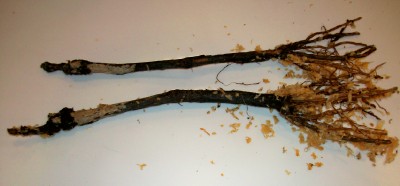 The
varieties I replaced were Arizona/Canyon, Sangiovese, Summer Royal, and
Chambourcin. None had performed well in the desert. Sangiovese
apparently does well at slightly higher elevations, but here I found
that it didn't have adequate vigor to protect the grapes from the sun.
Chambourcin (a French-American hybrid) has done well in some of the
warmer parts of France and Australia, but like Sangiovese, it lacked
sufficient vigor. I replaced these vines with Nebbiolo and Cinsault. I've had very good results with Nebbiolo, except for rather weak color, and Cinsault has a good track record in southern France and Algeria, so I have high hopes for it here. Since my last post I started and finished fermentation of the second half of my Pseudo Tuscan. This is an eclectic blend of my own red grapes. These grapes had been taking up space in my deep freeze since harvest; it took a while to find the time to take care of the fermentation. September 22 - I finally watched Blood into Wine last night. This is a pseudo documentary that tells the story of Maynard Keenan and Eric Glomski making wine and bringing credibility to Arizona wine making. If you have any interest in Arizona wine you must watch this film. MLF was finished in my Tempranillo, so I racked it last night and treated it with SO2. I tasted a small sample, and it was fantastic. I think you could call the tannins "chewy". That's not a descriptor I frequently use. I'm looking forward to seeing how this will turn out. Half is aging now in my new Hungarian oak barrel, the rest is aging in glass carboys and will be blended with batches of Merlot and Syrah that are each slightly acidic and lacking in tannins. September 19 - The Sauvignon Blanc I was hoping to get from southern Arizona fell through, so I decided to put part of the Tempranillo in my new Hungarian oak barrel. In advance of that I attempted to get it prepared this weekend, but it was leaking like a sieve. Water poured out of it nearly as fast as I put it in. I placed the barrel in a large food grade plastic container that I normally use as a primary and left it submerged over night. I removed it today, refilled it with water, and although it's still leaking a little I'm cautiously optimistic I'll be able to get the Tempranillo in it by Tuesday. Also this weekend I pulled a large volume of assorted red grapes out of the deep freeze and started a cold soak. These are Nebbiolo, Tempranillo, Cabernet, and other varieties that will comprise my 2010 Pseudo Tuscan. As expected, the chemistry was way off. The pH was 4.21 and the TA was just 3. I've gotten into the habit of adding half of the necessary tartaric acid before the cold soak then retesting and adding the remainder just before pitching the yeast. By the way, my first article is in the Fall edition of Arizona Vines and Wines. You should be able to find this at most wine shops in Arizona. Take a look and let me know what you think. The next article is in progress; it'll be on varietal selection. September 15 - I made a trip last weekend to Missouri to visit family and friends, as well as attend a local fall festival. I had a great time, but while I was there I noticed that the Concord vine that's been in the family for generations was heavily loaded with slightly over ripe grapes. I initially dismissed the notion of harvesting the grapes and bringing them back due to the trouble and expense involved. I kept thinking though that a late season Concord wine might have some potential, so I scrambled to get them harvested and packaged for shipment. Sometimes opportunities like this present themselves and you just have to go for it. September 6 - Dealing with Stinky Wine I long ago decided to limit topics on this blog to just those that are of special interest to desert grape growers and wine makers. For that reason I've never addressed H2S (Hydrogen Sulfide) in any detail. I'm starting to think however, that desert grown grapes may be more likely to lack certain nutrients, nitrogen in particular, since our soils are somewhat marginal. This may contribute to H2S production during fermentation. So lets take a look at this stinky problem. First, let's review the chemistry. Hydrogen sulfide can be produced during fermentation when the yeast attempts to make methionine in a low nitrogen must (juice). When nitrogen is abundant, sulfide produced by the enzyme sulfite reductase combines with nitrogenous precursors to form methionine. If these nitrogen precursors are not available the sulfide diffuses through the cell walls as hydrogen sulfide. If that's all too technical for you, here's a more approachable explanation... unhappy yeast make stinky wine. Regardless of the science behind it, the production of H2S is a real problem because it's detectable in very small concentrations. In most cases H2S smells like rotten eggs, but it may also smell like garlic that has gone bad. If the problem is not addressed quickly enough, mercaptans may form due to the interaction of H2S with alcohol and amino acids which can create odors reminiscent of burnt rubber, onions, and skunk. There are a few possible causes for H2S production in wine. For example, very high fermentation temperatures may contribute to H2S production, and rotting lees can cause this problem as well, but the single biggest cause is a nutrient deficiency, especially nitrogen. Before Fermentation It's best to stop H2S before it starts. Many home wine makers and even some commercial producers don't understand the differences between nutrient products. Let's take a look at a few of the common ones. 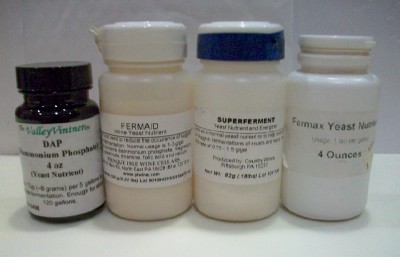
GoFerm can also help get your yeast off to a good start. It's a bit different in that it's not added to the must, but instead it's added to the rehydrated yeast before it's pitched. Since H2S usually doesn't show up until later in the fermentation, it doesn't seem like using a yeast energizer at the start could help, but it does make a difference. A staggered approach to nutrient addition is generally recommended. Many suggest splitting the nutrient additions three ways, with 1/3 added at the start, 1/3 added after fermentation has become vigorous, and 1/3 added when Brix has dropped to around 10°. Some suggest splitting the DAP between the first two nutrient additions, since yeast cells may not be able to use it effectively once alcohol levels rise. During Fermentation H2S is one of those problems that should not be ignored. The earlier you deal with it the easier it will be to eliminate. If you start to smell the telltale aromas of H2S during fermentation you should immediately: If you're wine is fermenting in an open primary, stir like you've never stirred before! If it's in a carboy, rack and rack again, while encouraging a lot of splashing and foaming. This aeration can have the effect of knocking the H2S molecules out of solution. If the H2S was just created, it's not bound to anything and it's quite easily dissipated this way. Since the must/wine is probably loaded with CO2, there's little risk of oxidation. Also, oxygen is a necessary nutrient for yeast health. Introducing a small amount may make the yeast a bit happier and reduce their production of H2S. As discussed earlier, a staggered approach to nutrient additions is recommended, but if you've already added all of the nutrients but you start to detect H2S anyway, there's little risk in making another small nutrient addition. Generally nutrient additions beyond what the remaining fermentation can use are not recommended. As long as fermentation is not fully complete, a small dose of nutrients should be fine. How much exactly is difficult to say. There are no "rules of thumb" on this topic. Nutrients high in nitrogen are the obvious choice, but adding DAP late in the game is of little help since the yeast can't use it effectively if alcohol levels are too high. 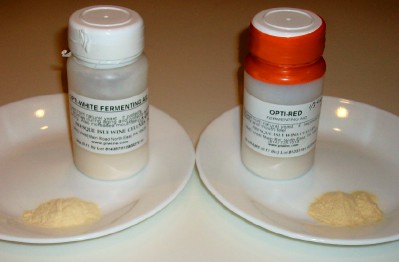 In recent years yeast based products like OptiRED have emerged as a clear favorite among hobbyists for dealing with H2S. The exact mechanism for why these products help has not been determined, but it's presumed that these yeast based products simply act as sponges, pulling H2S out of solution. It's important to note that using these products like this is somewhat "off label". That is, they are intended to be used to improve mouth feel or color stability. If those are qualities you're looking for anyway, you might want to consider adding them at the start of fermentation. Be advised however, that if you're trying to make a crisp, clean white wine like a Sauvignon Blanc, adding a product like OptiWHITE may take your wine in a different direction. The fuller mouth feel and impression of sweetness these products provide may result in a much different finished wine than what you intended. Still, that might be better than rotten eggs. These yeast based products can be added at any point, before, during, or after fermentation. There are some different thoughts on the advisability of adding sulfites (SO2) while dealing with an H2S problem. The consensus seems to be that it's best to complete all remediation steps before adding sulfites to protect the wine. There's some chemistry behind this that I won't attempt to explain at the moment. Immediately After Fermentation If you don't notice H2S until fermentation is completely finished, your best bets for dealing with it include:
Yeast hull products can be added at any point, even after fermentation is complete. Left in contact with the wine for a really long time, without being stirred, they may cause off flavors as they autolyze, but that's really the only risk associated with their use. 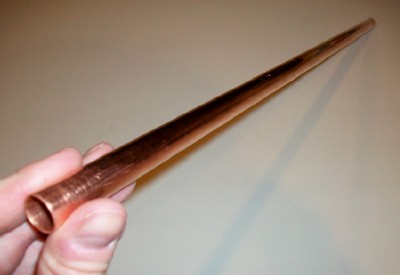 With fermentation complete, copper becomes a treatment option. It can be added by using:
You really need to know what you're doing before you add copper sulphate to wine. If you add too much you could actually make it poisonous. This is serous stuff folks. For this reason I've never used it, but many do. Many wine makers use older pennies and simply rack the stinky wine over a handful of older coins or throw a few into their carboys. I haven't found the practice to be very effective however. Instead I recommend copper pipe. Common 1/2" copper pipe, like that available in any hardware store can make an excellent H2S remediation tool. Use emery cloth or steel wool to take the pipe down to the bare copper. Any printing on the pipe needs to be removed. I've found that concentrated ascorbic acid (crushed vitamin C tablets in distilled water) can be very effective at cleaning copper. It effectively etches the surface, stripping away anything that doesn't belong in your wine. Pushing paper towels down the pipe with a wood dowel is a great way to clean the inside. This pipe can be used to stir a tainted wine, or you can rack your wine through it with it placed in the receiving carboy or barrel. Some wine makers expose all of their wines to copper in some form after fermentation as a preventative measure. There is a small risk though of creating a haze or off flavors when using copper, so there are some risks to consider. Long After Fermentation This is where things get difficult. If you let H2S go too long complex sulfur compounds can form due to the interaction of H2S with various constituents in wine. The aforementioned treatments won't be very effective unless you can break down these complex compounds and one way to do that is with ascorbic acid (vitamin C). After adding ascorbic acid, copper can be an effective treatment. Yeast hull treatments may also be effective at this point. Additional information can be found at:
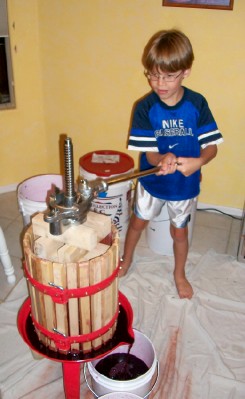 There
are several topics related to this batch of Tempranillo that I'd like
to cover. First, the vineyard owner was not weighing the fruit that we
harvested. He simply suggested that we go with a 21 pound per 5 gallon
bucket estimate. Several of us ended up with a gallon of pressed wine
for every 14.8 pounds of grapes. That's somewhere between
typical
and low, depending on how hard you are pressing, whether or not you've
used any enzymes, and whether you did extended maceration. However, one
of our group ended up with quite a bit more finished wine. He got a
gallon wine for every 10.5 pounds of fruit. It's likely that they
harvested more fruit than they thought. Another possible factor is the
way they were pressing. They used a bladder press, which is more
effective than a conventional ratchet type press like that in the
picture above. The second item I'd like to cover is yeast selection. I split this batch three ways and used three different yeasts; BM4X4, RC212, and D47. The first two are fairly conventional choices for red wine, but the third is a bit unusual. D47 is normally used with aromatic white wines. It helps preserve and enhance those flavors. By using these three yeasts and blending the resulting wines, I hope to end up with a more complex wine. Finally, it can be hard to find fresh wine grapes and juice in Arizona. Back east many fruit distributors will bring wine grapes in from California and Chile, and of course in California many sources of grapes are available. Here in Arizona though finding fruit takes a bit of work. Your best bets for finding fruit or juice are 1) check with the local home brew shops mid summer to see if they are aware of any local fruit distributors bringing in California wine grapes or juice, 2) check southern Arizona listings on craigslist.com, and 3) join AZWineMakers.com. Sometimes a member of our group may be aware of a source of grapes that's not widely known, or they may be able to arrange a group-buy from a vineyard that doesn't normally sell grapes to hobbyists and smaller commercial wine makers. August 23 - Harvest is done! I brought in the last of the Nebbiolo yesterday. That was the last variety to harvest. I made a trip down to southern Arizona Saturday to harvest a small quantity of Tempranillo. The fruit was partially damaged by hail, but the numbers were good and I have high hopes for this wine. August 20 - Since my last post I did another partial harvest of Nebbiolo. Determining which bunches to bring in is more of a guess than anything else. Nebbiolo has always been one of my favorites, but this year it just hasn't ripened as well. It's struggling to hit 22 Brix and I'm still seeing a lot of green berries. At the same time I'm losing some fruit to dessication. Harvest at my San Tan vineyard is complete. I harvest the last of the Concord Seedless this week and removed the bird netting. By the way, when laying out a vineyard try to limit rows to just one variety. I say this because the bird netting has to go up when the first variety hits veraison, and it doesn't come down until the last variety is harvested. The longer it stays up though, the more problems you have with canes growing through the netting. This can be a real hassle to sort out when it's time to remove the netting. I'm getting up tomorrow at 3:30AM to harvest Tempranillo near Benson. I'm just getting a small amount to round out my own 2010 production. There are sources of grapes and juice in Arizona if you do your research and make some calls. Unfortunately I have some bad news to share. While the vineyard I'll be at tomorrow has been unaffected by recent storms, most of the vineyards in southern Arizona got pummled by hail this week. Here are some articles on the subject. August 11 - I did a partial harvest of Nebbiolo Monday. The seeds are solidly brown but the color isn't yet what it should be and the Brix was just 21. I only did this partial harvest because I was seeing a lot of raisining in the fruit. After bringing in the grapes I did a careful hand-sort to eliminate any under ripe berries. August 8 - I just brought in the Cabernet Sauvignon. The Brix had climbed to 25 and the berries looked fairly evenly ripened. It's nice not to have fool around with a split harvest. August 7 - While I enjoy most aspects of growing grapes and making wine, there are a few things that I find especially satisfying. One is harvesting perfectly ripened grapes; our desert climate offers so many challenges that when a vine does produce perfectly ripe grapes, I'm thoroughly happy. Another is opening a bottle of wine made entirely from my own grapes; few things are as satisfying as that. Finally, it's always exciting when a new oak barrel arrives. There's something about the smell of the oak and what I know that will bring to my wine that makes the whole experience memorable. Well, this week I took delivery of my second Hungarian oak barrel from Vadai. 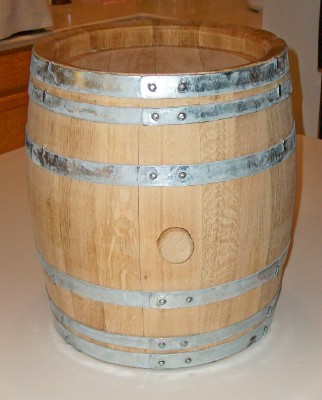 I think the two most important things wine makers can do to improve the quality of their wine are 1) get better fruit, and 2) use oak barrels for aging. I certainly saw a dramatic improvement in quality when I started aging in oak. On another topic... this has been a tough year for my Tempranillo. I harvested the last of it this morning; I was hoping that the last few clusters would fully ripen, but they didn't. I think this variety was challenged this year by the mild weather we had in the spring. Although I originally felt that the weather was a blessing, for the Tempranillo at least it may have been a curse. This variety normally ripens early, thereby missing some of the worst of the heat. This year though veraison was delayed by the cool spring weather. Just as the grapes were starting to ripen, the heat really came on strong. This may have stressed the vine and hindered ripening. A variety that has really surprised me though is Cabernet Sauvignon. 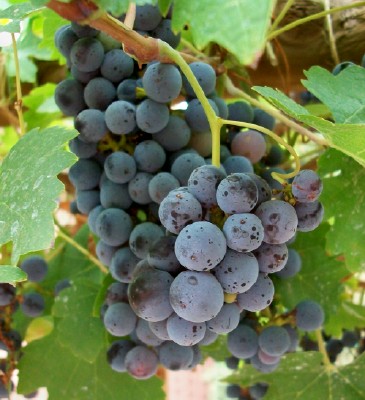 I wouldn't have thought this variety would do so well in the desert, but this is the second year I've let my Cab produce grapes and both years the berries have ripened fairly evenly without much in the way of raisining or other problems. I think desert grown Cabernet is best used for blending though, since hot climate Cabernets just don't taste the same as those from a more moderate climate. If you've ever had a Cab from the bargin bin at your local liquor store, then you know what a hot climate Cab tastes like. Many of the least expensive Cabs from California come from the hot Central Valley region. These hot climate Cabs just don't develop the same structure or character. Still though, desert grown Cabernet Sauvignon has a lot of possibilities for blending. Finally, you have to know when to cut your losses and abandon a failed effort. I say this for two reasons. First, after struggling for over a year to correct an H2S problem with an Acer (Maple) Mead, I've come to the conclusion that I'll never be able to get the H2S below a detectable level. I really don't need much good Acer Mead; I have no use at all for bad Acer Mead. Still, dumping a wine is something I find hard to do. Sometimes you just have to bite the bullet and do it anyway. I've also decided to drop-kick several grape varieties, namely Canyon/Arizona, Summer Royal, Sangiovese, and Chambourcin,. Now the first two should be no surprise if you've been following this blog for some time. I tried to graft them over to something else in the spring, but the grafts didn't take. I've just decided to skip the grafting and replant with something more appropriate. I haven't talked about the last two (Sangiovese and Chambourcin) though. Neither is producing enough of a canopy to protect the grapes from the intense sun, so I just don't think they're appropriate for our climate. The Sangiovese might have done better on another rootstock. It's on 110R, which hasn't proven to be a great rootstock for the desert. I'll likely replace these vines with Nebbiolo on SO4, Cinsault on 1103P, and Thompson Seedless on its own roots. Nebbiolo of course does well here (as long as you're not expecting deeply pigmented wine), and while I haven't tried Cinsault, it has a long track record in Algeria, which has a climate very similar to ours. The second best time of the year around here to plant grapes is mid-September, so I'll likely replace these vines in just over a month. August 1 - Since my last update I pressed that small batch of red blend. It smells great and the color is good. The white blend has continued its long slow fermentation at 60 degrees. The SG is now 1.016. I'll probably rack it over to glass carboys tomorrow for bulk aging. Through the first five days or so of the fermentation, I added the yeast nutrient and energizer in small doses. I think most yeasts perform better when they're fed in increments like this. The Nebbiolo is presently at 17 Brix, and the Cabernet Sauvignon is just north of that. Both will be harvested in due time. July 26 - I harvested the Muscat at my San Tan vineyard over the weekend. That was the last of my white grapes for the year, so I spent Sunday destemming, crushing, and pressing white grapes. Some of the grapes were already destemmed and frozen several weeks ago. This is a practice I'd like to get away from because I think it contributes to browning of the must. I'm not terribly worried about the browning though, since it looked just as brown last year and the wine eventually took on an attractive straw yellow color. This batch is about 70% Muscat, 15% Thompson Seedless, 10% Viognier, and 5% Sauvignon Blanc. In retrospect I'm not sure why I added the Thompson Seedless. I was thinking I needed the extra volume but since I'm planning on sourcing some Sauvignon Blanc from southeastern Arizona it was rather pointless. The SG from this white blend was 1.084; a bit low because I harvested the Muscat at my Superstition vineyard early. The pH came in at a respectable 3.85. This would be quite high anyplace else, but I was pleased with it. It took about 7 grams per gallon of tartaric acid to get the pH below 3.5. I'll test it again post fermentation (3.2 to 3.3 would be a better pH). I pitched the yeast (D47) on this batch this morning, and will do a cool (~60 degree) fermentation over the next week. As I write this I'm enjoying a glass of the 2009 Tres Blancos white blend. My approach this year (OptiWhite, D47, cool fermentation, etc.) mimics what I did last year. I also harvested the Barbera at my Usery Pass location. The vines are only in their second season, but they were doing so well that I allowed them to produce a few bunches. That just leaves the Nebbiolo, Cabernet Sauvignon, some Tempranillo, and a little Concord Seedless to harvest at this point. It definitely feels like I'm on the home stretch. July 24 - I have a few different topics in mind today. Let's start with chemistry, or more specifically, acidity and pH. After refrigerating that mixed batch of crushed red grapes for a few days, I finally got around to testing the pH. It came in at 4.31. Yes, that's right, 4.31. That would be astonishing in any other part of the world, but here it's on the high side of normal. What did surprise me though was how a high pH could impair the color of the must. After a three day cold soak, the must had picked up very little color from the skins. But with the addition of some tartaric acid the color absolutely exploded. Clearly I should have added the tartaric acid before the cold soak. By the way, the rule of thumb for pH adjustments is that moving the pH by 0.1 requires 1 gram of tartaric acid per liter of must. In my experience though this is about twice what is typically required. The relationship between acidity and pH is neither linear nor consistent, and it can be influenced by any number of chemical constituents in the must. So if you are trying to lower the pH of your must, proceed carefully. Next let's consider the weather. This year we had a wet spring followed by a very mild May and early June, then the heat came on with a vengeance in July. This contributed to some variation from past years with respect to bud break, veraison, and ripening. Varieties like Muscat and Tempranillo which have been consistent performers struggled this year in the heat, but varieties like Syrah, Viognier, and Sauvignon Blanc were nearly perfect (ripe berries, little sunburn or raisining, etc.). It really seems like "when" it gets hot is much more important than "how hot" it actually gets. Another thing I've come to believe is that humidity is important. My vines seem more stressed early in the summer when temperatures can be extreme but the humidity is low, than they do later in the summer when the humidity can be a little higher. July 20 - I'm getting the first red batch started. This is a blend of the odd assortment of red grapes harvested so far. If you've ever looked at my wines page, you've probably noticed the long list of varietals and wines. Actually, at this point I don't have the volume of grapes necessary to make all of those wines. All of the red grapes end up in my "kitchen sink" blend I call the Pseudo Tuscan. Anyway, with that little admission out of the way, I'll add that like last year, I'm doing a three day cold soak followed by a week long fermentation at 80+ degrees. Also like last year, I'll use OptiRED, a tannin product, and an enzyme. These products will improve color extraction and stability, and reduce vegetal notes from any green seeds that may have slipped into the must. July 18 - It's been a busy weekend. I harvested Viognier, Syrah, Petite Sirah, and part of the Flame Seedless and Concord Seedless. The heat is really taking its toll on the Muscat at my San Tan vineyard and the Tempranillo at my Superstition location. Berries are going straight from green to brown or raisins. It's important to note that in a more moderate climate, raisining would not be a big issue. I've tasted many commercial wines (especially Zins from California) that were obviously harvested late. The subtle hint of raisins isn't necessarily a problem. Here though some grapes may not ripen completely before succumbing to the hot sun; this may leave tannin and color lacking and Brix below 20. 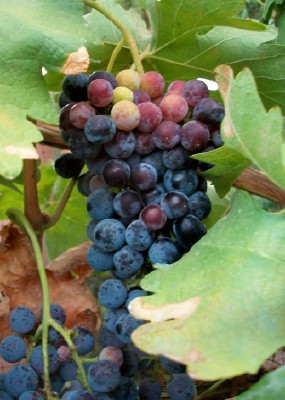 Although hard to see in the picture above, some grapes are raisining while those at the top are still green or under ripe. Maintaining a dense canopy and providing ample water can help reduce this problem, but unorthodox stratagies like split harvests and hand-sorts may be required. On a related topic, the irrigation system at my San Tan vineyard is becoming increasinly compromised. With the water turned on, little makes it out the drip emitters. However, the vines have never been happier. The numerous below grade, mole-induced leaks are apparently providing ample flow. The healthy condition of the vines has me questioning my previous thinking about watering. I've long said that 20 to 25 gallons per week per vine was sufficient mid-season, but now I'm thinking that in some cases more may be needed. The soil at that location drains well, so perhaps more is needed. Next year, with the new irrigation system in place, I'll try 30 to 35 gallons per vine per week. Finally, I'm sometimes asked how I determine when to harvest. Normally one would look for Brix, acidity/pH, and appearance. By appearance I mean the color of the skins (for reds), seeds, and stems. Brix and appearance are still good indicators in a hot climate, but you can pretty much ignore acidity or pH. By the time the grapes are ripe acidity will have dropped too far. This is easily addressed though by adding tartaric acid at crush. The riper Tempranillo berries at my Superstition vineyard are around 19 or 20 Brix. The seeds are brown, but obviously I need to get the Brix a bit higher before harvest. I'd also like to see more of the green berries mature. I can hand-sort if necessary, but I could sure use the extra fruit. I'll likely harvest the Syrah at the San Tan vineyard this evening or tomorrow. July 12 - I made a trip down to my San Tan vineyard yesterday. The Syrah is looking great and the Brix is around 24 degrees, but a few seeds are still a little green. I'll check it again mid-week. The Viognier and Muscat are around 13 to 15 Brix and the Sauvignon Blanc is too green to even test. I did a quick taste test of the Concord Seedless and Flame Seedless; both need another week or so to ripen. The variation between varieties and locations from year to year is interesting. Usually Flame Seedless is among the first to ripen but this year it's going to finish mid-season. Also, there must be at least two weeks, maybe three, between the Syrah at my San Tan vineyard and the Syrah at my Superstition vineyard. July 9 - I harvested the Thompson Seedless at the San Tan vineyard the other day. Since these are table grapes, I didn't bother testing Brix or pH. I can tell you though they are delicious. There was a significant difference in berry size between those from the girdled vine and those that weren't. 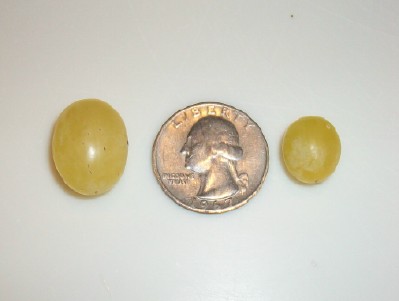 The
berry on the left is from the girdled vine; the one on the right is
from
a vine left alone. Next year I'm girdling all of my Thompson Seedless
vines. Sangiovese continues to be a disappointment. This variety produced very few berries this year at my Superstition vineyard and most were badly dessicated before they were ripe. This is the third year of disappointing results from this variety. Next year I'll graft over to something else. I harvested the Muscat at my Superstition vineyard this morning. Not because the grapes were perfectly ripe, but because I was seeing a lot of raisining and just decided to cut my losses. Before crush, I'll do a careful hand sort and remove any berries that are too green. Normally this variety holds up well in our heat. I'm not sure why it suffered this year. The muscat at my San Tan vineyard is looking great so far. July 7 - I've just returned from vacation in Brazil. Yes, taking vacation at such a critical time in the vineyard may not be advisable, but I have returned to find things in good shape, at least at the Superstition vineyard. I'll check on the other two locations in the next few days. Upon my return I did find greater than normal dessication of Muscat grapes at the Superstition vineyard. Temperatures were above normal during my absence so this isn't unexpected. Brix on the good fruit is around 20 degrees and the seeds are mostly brown, so I probably won't hold off on harvest for much longer. June 26 - I've finished hanging bird netting on all of my vines. This is my least favorite task in the vineyard, but it's absolutely essential in this environment. The birds would leave me nothing without the netting. With the above average temperatures we've been having, my grapes are ripening at an accelerated pace. Syrah at my San Tan vineyard already has some berries at 19 Brix., and Thompson Seedless will be ready to harvest in a week or so. I'm putting the finishing touches on an article for Arizona Vines and Wines. Look for it in the Fall issue. A number of other responsibilities will be keeping me occupied for the next week or so. I won't likely post again to this Blog until July 6 or 7. June 22 - It has come to my attention that the EPA has not approved Permethrin for use on grapes. Strangely, the nearly identical Pyrethrin is approved for use on grapes. Go figure. In any case, it will be removed from a future rewrite of the disease management article. June 19 - More varieties are going through veraison. Over the last few days both the Syrah at my San Tan vineyard and the Tempranillo at my Superstition vineyard have shown the first signs of color. I'm now scrambling to get bird netting in place before the birds eat too many grapes. My previously mentioned spraying schedule for 2010 has successfully held the insects at bay. I've had virtually no insect damage all season. In past years I've struggled with grape leaf hoppers and leaf skeletonizers, and last year I saw damage that was almost certainly caused by leaf cutter ants. Well... the insect situation is the good news. Unfortunately, my spraying schedule hasn't been as successful with powdery mildew. I think I know where I went wrong though. I've been alternating every two weeks between an application of a fungicide and an insecticide. While some fungicides have insecticidal properties, few insecticides have any impact on mildew, and with up to four weeks between fungicide applications powdery mildew has had a chance to get reestablished. Next year I'll add a pre-season application of lime and stylet oil, spray more frequently throughout the season, and add a synthetic fungicide to the rotation, possibly Myclobutinal. For now, I'm applying a solution of baking soda (sodium bicarbonate), liquid soap, and water to bring the powdery mildew under control. June 14 - Véraison!!! Actually, it was Saturday, June 12, that I saw the first signs of color on any of my grapes. This year Mars Seedless and Petite Sirah at my Usery Pass vineyard share this honor. For the last two years Tempranillo has been the first to go through véraison; in 2008 this happened on June 9th and in 2009 on June 5th. Our cooler than normal May weather has slowed things down a bit this year. Tempranillo my still be two weeks away from the first hints of color. I met with Sam Pillsbury at his vineyard near Willcox Sunday, along with several members of AZ Wine Makers. 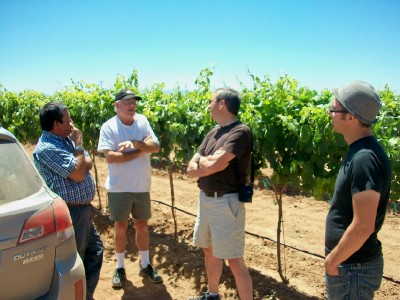 Our discussion with Sam focused on opportunities for collaboration or investment. The discussion was productive, informative, and a lot of fun. I hung the first of the bird netting today. All of the vines at my Usery Pass location are now netted. Just days into veraison it was obvious that the birds had also noticed the ripening grapes. If you have a vineyard in a more urban location, you'll have no choice but to cover them with netting. I've gotten along well with the black nylon netting available at any garden center. Applying netting is a bit like herding cats. The netting hangs up on everything. This is definitely a two person job. I roll the ends and bottoms of the netting with my hands, then I use clothes pins to secure it every few feet. Birds are persistent and if any gaps remain, they will find them and make their way to your grapes. They may not, however, make it back out again. It's important to keep an eye on things once you've hung netting. June 6 - The irrigation system at my San Tan vineyard is leaking again. I suspect that the gophers and/or moles have chewed another hole in the line somewhere. Right now all of the vines are still getting pretty good flow so I'm not going to worry about this just yet. In the fall I'll redo the irrigation system and place the majority of the lines above ground and out of reach of the obnoxious rodents. I've bumped up the watering schedule to about 20 gallons per vine per week at each location. With daily highs in the neighborhood of 110 degrees, I think the vines need it. There are several ways to gauge the water requirements of your vines. Since I have twenty-two varieties spread across three locations, I tend to think in more general terms. I know that on average, my vines need about 20 to 25 gallons per week mid-season. Some might benefit from a little more than this, while others probably don't need that much. For comparison, Father Menas at St Anthony's gives his vines 30 to 35 gallons per week. There are several different ways to determine the water requirements of your vineyard; You can use rough approximations like I do, take measurements and make calculations, or you can evaluate the condition of the tendrils. I'm not in the mood to deal with measurements and calculations at the moment, but a member of our wine makers club did touch on this subject in a paper he wrote for our club website. Let's instead focus on tendrils. 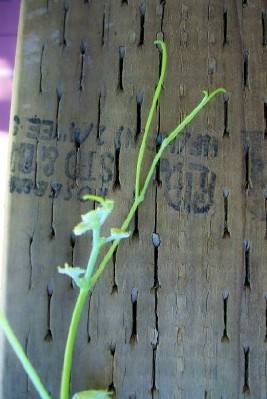 Generally if vine tendrils extend beyond the shoots, like in the photo above, the vine is getting plenty of water. However, the reverse may not always be true. If the tendrils don't extend beyond the shoots, it may mean that the vine isn't getting enough water but it may just be that the vine isn't in a "growing mood". There's an ebb and flow of vine growth that doesn't seem to be connected to factors like irrigation. The condition of the tendrils is another indicator or irrigation sufficiency. In my recent discussion with Chuck Blethen, he indicated that he used the firmness of the tendrils as an indicator and frequently modified the irrigation schedule accordingly. Firm tendrils indicate sufficient water, while limp tendrils indicate insufficient water. It has been said that "vines don't like wet feet", which may lead one to limit irrigation. However, in my experience too much water is far better than too little. If you're not sure how much water to apply in you vineyard, err on the side of caution and give your vines plenty of water. On another topic, after finding Powdery Mildew on a Tempranillo vine, I sprayed it with Stylet Oil just days after a schedule spraying of Neem Oil. It seems that this spraying, combined with our recent high temps caused some leaves to shrivel and die. At least that's my theory. 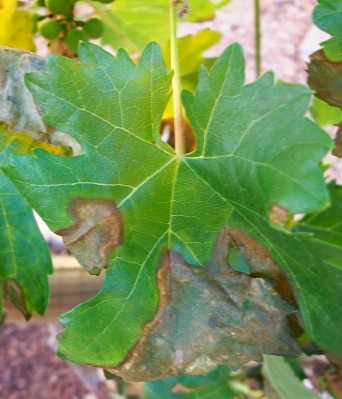 Some
fungicide and insecticide sprays can cause stress to vines when applied
in our summer heat. With our near record high temps, I've put scheduled
spraying on hold and switched to a defensive posture; I'll only spray
when I need to to deal with a specific problem. As soon as daily high
temps drop a bit, I'll go back to scheduled spraying but only late in
the evening when temperatures are a bit cooler. Finally, there's a great thread over on WinePress.US regarding canopy management. I suggest you check it out. May 30 - We've been lucky this year. Above average spring rainfall and lower than normal summer temps have been great for the vines. Unfortunately our luck is running out. The daily highs are getting back into the normal range and the extended forecast has high temps approaching 110 degrees. With that in mind, I've upped the irrigation schedule to about 17 or 18 gallons per vine per week at each of my locations. After bragging recently about the effectiveness of my spraying schedule, I found a few spots of powdery mildew on a Tempranillo vine. This was just after an application of neem oil, but not being sure that was totally effective, I immediately applied stylet oil. Still though, this has been a fairly problem free season so far and I'm still an advocate for scheduled spraying. May 25 - There are a few things I wanted to bring to your attention. First, the good news. Blood Into Wine is being screened at theaters around the country. This movie features Eric Glomski and Maynard Keenan, and tells the story of how they worked to bring credibility to Arizona wines. I have not seen it yet, but it's getting great reviews and more importantly, it's bringing awareness to the great things happening on the Arizona wine making scene. If you can't make it to a screening, definitely look for it on DVD. Now for the bad news. Congress is considering HR5034, a proposed law that could effectively end direct wine shipments in the US, and lead to the failure of countless small wineries around the country. This is really bad... bad for consumers, bad for small independent wine producers, and a terrible precedent for government interference in private enterprise. But it's really good for distributors, which is why it has gained traction and is being seriously considered. Fortunately there is a ray of hope; presently there is no companion legislation in the Senate, and this can't become law until that happens. Now is the time though to contact your representatives and senators and let them know how you feel about this travesty. May 24 - I can't believe the weather we're having. High temps have been below normal for a while and today it only reached 80 degrees. The vines are loving it. Last year at this time temps were considerably above normal and the vines suffered for it. I started a small batch of Blackberry Port today from my own blackberries. I followed Jack Keller's recipe with one exception; I'm sensitive (allergic?) to malt so I used bananas instead to add body. It should work. Only time will tell though. May 23 - I decided to try girdling a vine this week. After my recent experience with grafting, I was hesitant to start cutting on another vine, but I threw caution to the wind and tried it with one of my Thompson Seedless vines at my San Tan location. 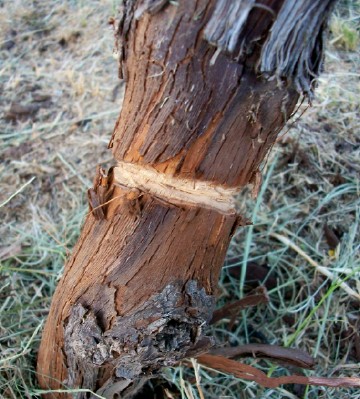 It's not even a week into this experiment and the grapes are already showing signs of increased size. Per my spraying schedule, I'm applying Neem Oil at each of my vineyards. The longer I go without seeing any serious problems the greater proponent I become for scheduled spraying. [Corrections made 5/24/10.] I had the pleasure this week of speaking with Chuck Blethen, Executive Director of the Southern Appalachian Viticulture Institute in Marshall, North Carolina. Now you may be wondering why I contacted someone back east to talk about grapes. Actually, up until three years ago Chuck lived in Scottsdale and during his last eight years in our state, he grew wine grapes and made some award winning wines. Here are my notes from the conversation:
I was also surprised he mentioned losing vines to Phylloxera in Arizona. The conventional wisdom holds that Phylloxera just can't live in our soils. This bolsters the argument for planting only grafted vines, even if you don't think Phylloxera will be paying you a visit. His watering schedule was less than my mid-summer peak of twenty to twenty-five gallons per vine per week, and substantially less than Father Menas' thirty to thirty-five gallons per vine per week. Using tendril condition as an irrigation gauge is certainly valid, but at my vineyards, mid-summer, I'd fear losing fruit due to dessication if I cut back any on the water. May 16 - The AZ Wine Maker's meeting was a blast. We tasted some great wines, exchanged notes, and discussed possibilities for collaboration in the future. You should really consider joining our group.
I finished the application of Sevin/Carbaryl at my Superstition vineyard today... none too soon as it turns out. As I was applying it I saw adult leaf skeletonizers flying around some of my vines. I could not locate their eggs or larvae, but they are surely around somewhere. The Sevin should take care of them. I've become a strong advocate for scheduled spraying. Even if you are going organic, or just have a few vines, scheduled spraying can really keep diseases and pests in check. I sampled a bit of the 2009 Pseudo Tuscan this evening. This is an unorthodox red blend comprised of Tempranillo, Nebbiolo, and a little bit of everything else. The 2009 vintage will be my second and I'm really pleased with how this is shaping up. The main difference for 2009 was MLF (malo-lactic fermentation). This greatly improved flavor and mouth feel. For 2010 I may not have the volume necessary to start barrel aging, but barring a disaster I should once and for all be done with using pasteurized juice or juice concentrate to round out the batch. I should have ample quantity for the volume I want to produce. May 14 - The vines are thriving, the weather is nice, and there's not much to worry about at the moment. Veraison should be about two weeks away for the earliest ripening varieties, so there's a bit more time before I have to hang bird netting. The blackberries are continuing to ripen. I harvest more every day. So far I've been able to keep ahead of the birds for the most part. I'm looking forward to making a port style wine out of this fruit. The second meeting of AZ Wine Makers is tomorrow, Saturday May 15th at my home. Please contact me if you are interested in joining our club. May 9 - I checked on the Usery Pass vineyard today. Everything looked good except for signs of mite damage on one vine. Apparently the mites were not impressed with the Bordeaux powder I applied a few weeks ago. Perhaps the Sevin that I sprayed today will leave a stronger impression. I'm trying to stick with the spraying schedule I shared with you a while back. So far there have been few signs of problems. May 5 - With the temperatures quickly increasing, I've increased the irrigation at all three locations to 14 or 15 gallons per vine per week. The grapes are maturing rapidly. Veraison will occur in about a month on some vines. There's not much to do in the vineyards right now except basic maintenance and spraying. May 2 - St. Anthony's Monastery 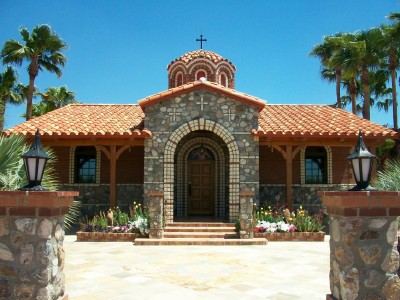 The AZ Wine Makers trip to St. Anthony's Monastery was a lot of fun and very informative. 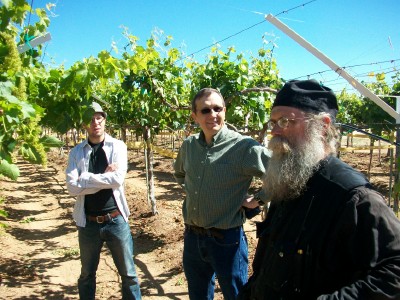 Father Menas was an enthusiastic and gracious host. I could easily write a full length article on the whole visit. Unfortunately I don't have the time for that right now, but I do want to post a few pictures and some notes of my observations.
St. Anthony's has about 2000 vines on roughly 2 acres. The varieties are too numerous to detail in this post, but they are for the most part the typical desert choices. The unusual ones are Black Muscat (Black Hamburg) and Aleatico. 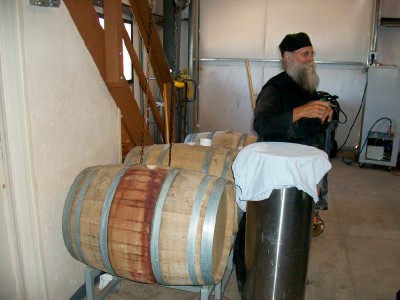 Although the wine Father Menas makes is for sacremtal use and for their own consumption, he generously shared samples of these and other wines with us. The Black Muscat was flavorful but difficult to describe. The Aleatico was quite good, but light on flavor and lacking in color. 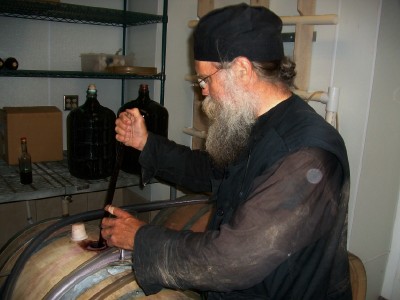 We also did barrel tastings of their 2009 Barbera and their Merlot/Syrah blend. Both were excellent; each had good color and were expressing notes typical of their varieties. One of the more unusual wines we tasted was a Retsina made from Thompson Seedless and flavored with pine resin from the trees of another monastery. Retsina may be an acquired taste, but Father Menas makes an excellent example of this ancient Greek wine style. 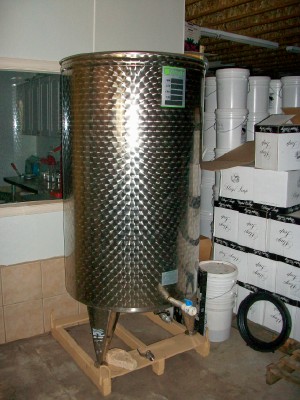 The winery building provides more room than they currently need. Too much room is never a problem though. The building features a huge walk in cooler, an adjoining room for barrel aging, and a room for testing and bottling. Well, I promised a short post on this topic, so just to wrap things up, here are some of my notes from the trip.
April 29 - I've given up on the field grafts. Despite early signs of success, both are clearly dead at this point. The roots are still viable though, so I'm allowing each to send out new sprouts. If they get well established this year, I may try this again next year. The postmortem revealed that the graft union did not heal over. I surely did something wrong... perhaps I waited too long and the vines were too near bud break, or perhaps the problem was related to my materials or technique. In any case, there's always next year. AZ Wine Makers will be visiting St. Anthony's monastery this weekend primarily to see their vineyard and wine making operation. If you want to join us, it may not be too late to get on the list. Just email me. April 27 - Over the last few days I've been dealing with irrigation problems at my San Tan vineyard. A lot more water was going into the system than was coming out of it. It turns out that I had a couple of massive leaks caused by moles and/or gophers chewing through the 1/2 inch poly pipes. In an effort to keep that vineyard neat and problem free I long ago buried the irrigation lines. It turns out that this was a mistake. The rodents don't bother the vines much, but they do have a habit of chewing into the irrigaton lines. I will likely never be able to completely eliminate them, so I'm thinking I should go ahead and place new irrigation lines in the vineyard, but this time suspend them from the trellises. This is actually a more conventional approach and would be lower maintenance even without the leak producing rodents. April 24 - Someone asked me the other day how many different varieties I'm growing. I couldn't immediately answer the question. I had to come home and review my notes to get an accurate count. I presently have twenty-two different varieties. They include:
Most of my vines are presently flowering or just slightly beyond that. I mentioned this recently to a friend and she said "they must be pretty". I had to stop and think about that for a moment. Clearly she was thinking of a different kind of flower. Appreciating grape flowers takes a good pair of eyes and some imagination. Here are a few pictures I took today.
My attempts at field grafting seem to be heading in the wrong direction. The Thompson Seedless on the Summer Royal roots at my San Tan vineyard hasn't yet gone through bud break. The Tempranillo on Arizona/Canyon roots at my Superstition location looked promising, but has since become severely distressed. 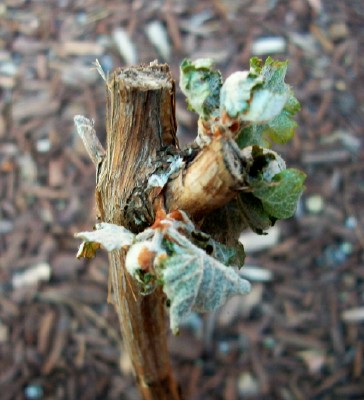 I
removed the tape from around the graft union. I thought maybe the vine
was becoming girdled by the tight tape. It's a long shot. I'm concerned
something else is wrong but there's not much else I can do. The roots
keep trying to send out new shoots. If the situation doesn't improve I
may just let it grow back and try grafting again next year. April 19 - It's "Vines Gone Wild!" around here right now. I'm seeing absolutely explosive growth at my Superstition and Usery Pass vineyards. The one year old vines at my San Tan vineyard are growing well but still lagging behind those at the other locations. .As you may recall I had a soil test done late last summer. The results showed some deficiencies at each location. In the fall I started applying various soil ammendments to address these issues. I only recently completed this process with a final application of Boron and Zinc at the San Tan vineyard. I think those soil chemistry adjustments combined with all of the rain we had in the spring set the stage for the vigor I'm seeing right now in the vines. I've modified the Upcoming Topics listed above. There have been several good threads on WinePress.US lately about soil chemistry. They have inspired me to write a standalone article on soil chemistry and terroir. April 5 - I was racking wines this evening (nothing from my own fruit) and I noticed the carboy of Prickly Pear wine resting in the back of a cabinet. It's been there quite a while. If you've been following this blog for some time you may recall that I wrote about my problems with this batch before. It had a strange, slimy viscosity that made it undrinkable, and early on even un-rackable. Well, I drew off a small sample, and as I hoped, age has helped the mucilage (the source of the problem) to settle out a bit. It still has a lot of mouth feel, but it's no longer slimy. This is one strange wine. The color is not as vivid as it once was, but the flavor is still unlike anything else I've ever tried. I lack the vocabulary necessary to describe it. I think it may be an acquired taste. April 4 - Happy Easter! I forgot to mention a few things yesterday that I wanted to share. I opened a bottle of my 2008 Pseudo Tuscan at party a few days ago. It's really coming around. It's been a while since I opened a bottle and the extra time in the cellar has certainly improved this wine. It may never be a "special occasion" wine, but it's certainly a great light Italian style wine for pizza night. Also, I know for many urban dwellers the idea of having a vineyard out of town somewhere is a popular one, but this type of arrangement can be more challenging than one would imagine. I'm fifteen minutes away from my Usery Pass vineyard and about twenty from my San Tan vineyard. During the spring and summer I try to visit each about once a week. This is a workable situation but it isn't ideal. You see, there's nothing better for a vineyard than footsteps. You need to be in your vineyard periodically to check for problems, repair trellises, control weeds, etc. Left unchecked, something like Leaf Skeletonizers can do a lot of damage in just a few days. If you're only visiting your vineyard every few weeks, insects can destroy whole vines in your absence. Deer, rabbits, and javelinas can also be a huge problem for grape growers in less urban environments. I would never try to dissuade someone from pursuing their dream of having a vineyard, but you need to plan on spending a substantial amount of time at your vineyard, especially early on. April 3 - I just had a few random thoughts to share with you today. First a quick status. The trellis project at the San Tan vineyard is finally complete. I think it looks really good, and the use of turnbuckles on all wires will help keep things tight in the years to come. The application of Neem Oil is also complete at all three vineyards per the schedule I previously outlined. As I developed my spraying schedule, I assumed that fungus (mildew) control would be more important earlier in the season, thus I scheduled spraying Stylet Oil and Neem Oil within weeks of each other around bud break. This morning I was listening to Rosie on the House on AM radio and one of the topics was the widespread problems this year with both Powdery Mildew and Downy Mildew. I can attest the the fact that Powdery Mildew can be a problem here but Downy Mildew is not normally an issue. With all of the rain we had this spring though, it's rearing it's ugly head all over the place. I'll sleep well knowing that all of my vines have been treated twice with fungicides in recent weeks. Next let's talk blackberries. No, not the kind that you communicate with, but the kind that you can eat and make wine from. If you've been following this blog for some time, you may remember that I recommended Rosborough and Womack as good varieties of blackberries for the desert. Seeing the incredible growth that these plants are putting on this spring, I am even more convinced than ever that these are great varieties for the desert. I should be harvesting blackberries in the next four to six weeks; I'm looking forward to making blackberry port from my own berries this year. Finally, as I'm sure you've noticed, I tend to stay pretty much on topic in this blog. I try to focus on desert viticulture and wine making, with occasional diversions for Arizona commercial wines and wineries. Some with wine blogs will expound upon political and philisophical topics, and frankly, there's nothing wrong with that. It's been said that "freedom of the press belongs to he who owns the press", and I really believe that. If someone has taken the time to author content and find a way to post it on line (usually by paying for web hosting), then what they post is their own concern. I just figured early on that if you're reading this blog, it's because you and I share an interest in wine making. However, if you are interested in my thoughts on Health Care reform or what I'm doing today (outside of wine making), please join me on Facebook. I am an engineer by trade and presently work for a large defense contractor. If you want to join my professional network, feel free to connect with me on Linkedin. March 27 - It's alive!!! 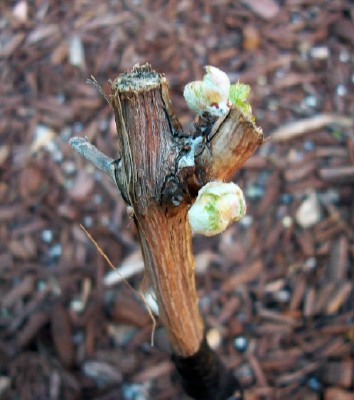 My Tempranillo grafted on the Canyon/Arizona roots has gone through bud break. I was really happy to see this. My other field graft (Thompson Seedless on Summer Royal) appears to have some buds that are swelling as well. Although it's too early to declare this experiment a success, it's good to see signs of life from these vines. As I previously mentioned, I bottled the 2009 Tres Blancos about a week ago. 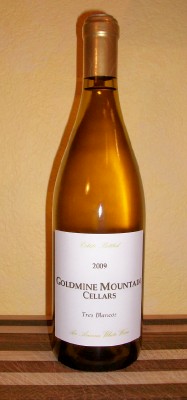 You may notice that the label looks a lot like that of the Pseudo Tuscan. That's not just laziness on my part. I intend to use the same simple, classic design for my mainstay wines. For the Rosé, Port, and Madeira I intend to use contemporary art on the labels provided by my friend Marina Rynning. Per my 2010 spraying schedule, I've been applying Neem Oil at all three vineyards. No signs of any issues yet. This is purely a preventative measure. With all of the rain we had this spring, I've had few concerns about irrigation. For a while now I had the timers set to provide five gallons per week per vine, but I would turn them off for a while after a rain. With most if not all of the rain behind us, and temperatures set to rise very soon, I've bumped up the watering to seven gallons per week per vine. March 21 - My lack of updates recently to this blog is not due to a lack of things to write about, but instead to a lack of time to write. Due largely to a hectic work schedule, I just haven't found the time to write about grapes and wine, but I have found the time to take care of a few things. My trellis project at my San Tan vineyard is finally underway. I only have one row to build, but I'm satisfied at this moment simply having started this project. The vast majority of varieties at all three vineyards have now gone through bud break. The remaining holdouts are the native and hybrid varieties, along with my two attempts at field grafts. I think there are some swelling buds on these field grafts. Only time will tell if they make it. I bottled the 2009 Tres Blanco this evening. As you may recall, at the start the must (juice) was very brown, however, at bottling the wine had cleared exceptionally well to a beautiful straw yellow color. The taste has also improved dramatically, but it still may be a bit "edgy". I've speculated that the flavor may have been impacted by greater than normal contact with the skins. A trace of H2S is still a possibility as well. Considering how this wine has improved during bulk aging, I'm cautiously optimistic that it will continue to improve in the coming months during bottle aging. Even now though it's a good wine and one that I'm comfortable putting the "Goldmine Mountain" moniker on. March 16 - I've been surprised this year at the variation in bud break, both from variety to variety and from location to location. In past years, my Tempranillo and Nebbiolo at my Superstition vineyard have been among my first vines to go through bud break; this year they are among the last. Also, my San Tan vineyard normally lags behind by several weeks, but vines went through bud break there first this year. A case of the stomach flu took the wind out of my sails this past weekend, so my trellis project at the San Tan vineyard remains to be completed. The vines won't wait for me, so I must get this done soon. March 7 - I noticed yesterday that one of my Barbera vines at my Superstition vineyard has gone through bud break. So I now have bud break at two of my three locations. I haven't been to my Usery Pass vineyard in the last week but I wouldn't be surprised if one or more vines there hasn't gone through bud break as well. I still have a bit more spraying to do. Per my schedule for 2010 spraying, I need to wrap up a pre-season application of Stylet oil right away, along with an application of Imidacloprid. I also still have some trellises to complete at my San Tan vineyard, but there will be time to get that task completed before the vines grow too much. This is the best time of the year to plant bare root vines; not a month from now, not two weeks from now, but right now. Vines planted now will go through bud break very soon and have the most time possible to grow before our summer temps become extreme. There's no reason to plant any earlier than this, since the vines will just sit there and remain dormant. There's been a lively discussion over on WinePress.us regarding the best way to plant vines; specifically whether to backfill the hole with native soil or use a blend of native soil and either store-bought garden soil or peat moss. I have tried both approaches and have had significantly better results when backfilling with a 50/50 mix of native soil and garden soil. The vines experience significantly better growth during the first year when planted this way. The argument for using 100% native soil is that it enourages the roots to grow out and away from the vine and reduces the likelyhood of the vine becoming root-bound. However, as I've dug holes for trellis posts in my vineyards, I've found no shortage of roots eminating from each of the established vines. I think the concerns with vines becoming root-bound are overstated. Based on my own experience I strongly recommend backfilling with a 50/50 blend of native soil and a quality store-bought garden soil. I previously provided vine planting instrucitons which I think are still valid, except perhaps for the recommendation to use Vitamin B. Although Vitamin B has long been used to reduce transplant shock and to improve first-year growth, several recent studies have found that it provides no benefit at all. There are several pro-biotic (benficial fungi) that are being increasingly recommended as a soil ammendment when planting bare root vines. The anecdotal evidence suggests that these work, but I haven't tried them so I can't advocate their use. February 28 - Bud Break!!! I visited my San Tan vineyard yesterday and found that two vines had gone through bud break in recent days; one was a Flame Seedless and the other was a Summer Royal. I was surprised by this, since that vineyard usually lags behind my other locations by a week or two. Unfortunately, the Summer Royal just hasn't worked out. This vine has produced fruit for the last two years. Each year it produced a good number of nice looking clusters, but as they started to ripen, the berries split lengthwise. I assume this has something to do with our extreme summer heat since I haven't found any mention of it anywhere on line. With this fatal flaw, the Summer Royal had to go, so I cut it down to the base and grafted Thompson Seedless on top of it. This will be my second attempt at field grafting this year. I hope that both attempts are successful. I should find out soon. I was poking around on line the other day and found a commercial wine maker using one of my wine names. Back when I picked Tres Blanco as a name for my white blend I made sure that no commercial wine maker was using it but I didn't register it as a trademark. I did explore the issue of trademark registration several years ago, but found that one really needs to be involved in "trade" or a commercial enterprise to register a trademark. For the time being I'll continue to use Tres Blanco but, assuming this other winery has since registered the name, I'll have to drop it if I go commercial in the future. I'm less concerned with the loss of this one name than I am with the implications for my winery name. I've grown rather attached to "Goldmine Mountain Cellars". I need to take steps to protect this and the other wine names I've chosen. February 22 - A fellow WinePress.us member posted this link today on breeding for resistance to Pierce's Disease. Although it would benefit from an audio narrative, there's a fair amount one can glean from the slide presentation. I thought you might find it interesting. February 20 - It's raining this weekend, so trellis construction and pre-season spraying remain on hold, but this does give me some time to catch up on racking wine and posting pictures. The following pictures were taken at our Arizona wine makers club meeting last Saturday.
As I mentioned on the 18th, I grafted Tempranillo on the existing Arizona/Canyon roots. Here's a picture of my handiwork. I'm anxious to see it grow. 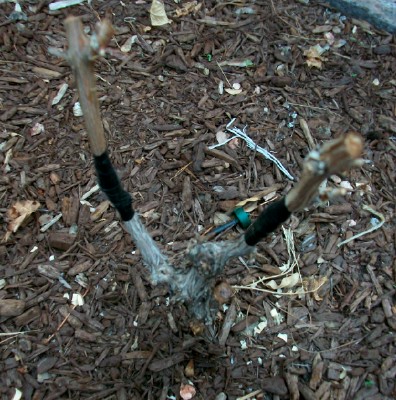 I don't have the time right now
to do a full article on trellis construction, but I did want to share
with you a few notes on how I've built mine. My basic design was
inspired by one I saw in a book, though at the moment I'm not sure
which one. My standard trellis is comprised of two treated 4x4 posts,
with treated tree stakes used as horizontal members placed at about
three feet and six feet. At four and five feet, I string vinyl
coated wire between eye hooks. This design can stand on its own or be
used at the end of a row. When used at the end of a row, I always place
the posts in concrete. Quikrete is perfect for this. Just
dump it in the hole, add water, and you're done. I also use treated
4x4's in rows, generally placing them after every other vine. That is,
two vines are placed between posts. It's generally best to set these
posts in concrete as well, but if your soil is hard packed and
alkaline, and you dig the holes deep enough, this may not be necessary.
There are less expensive ways to build trellises, but with my vineyards located in more of an urban environment, I wanted to make them aesthetically pleasing and lacking anything like anchor wires that could be a tripping hazard. I also needed to build trellises with materials that were available locally. If I lived in the midwest, I'd probably be using rough hewn hedge posts. Here we have treated 4x4's and tree stakes, so that's what I use. These treated 4x4's have a tendancy to warp or bend as they dry. Try to find those that are straight, already dry (they will be lighter), and are at least relatively free of knots. If you're going organic, then treated lumber is off limits. Steel fence posts are fine, but I'm not sure what to suggest for the end posts. I always bevel the top of the posts. I think this is a nice finishing touch. This can be done with a circular saw set to a 45 degree angle. Be careful when using a saw up high like this. It's important to paint or stain the top of the post if you cut it. The exposed, untreated wood at the center will start to rot and deteriorate pretty quickly otherwise. Alternatively, there are copper caps available at many hardware stores that protect the post top and give them a finished look.
No matter
what kind of wire you use, over time it will sag. It's a good idea to
use a
turnbuckle so that you can periodically tighten things up.
 That's it for now. I've decided to do an article on recommended reading. Look for that soon. February
18
- I completed pruning the last few vines at my Superstition vineyard
today. That just leaves the San Tan vineyard yet to be pruned. The
temperature is a few degrees cooler down there, so bud break
is still some time away. Last year the first vines to experience bud
break were at my Superstition and Usery Pass locations; the varieties
were Tempranillo, Nebbiolo, and Thompson Seedless and bud break
occurred around March 2nd. I also completed field grafting Tempranillo on the existing, established Arizona/Canyon roots. I'm anxious to see if this works. The other day at work a friend complimented me on a bottle of Melomel (fruit/honey wine) that I gave him a long time ago. I had actually forgotten what I gave him, but he told me that I warned him that it wasn't very good and that he should use it as a marinade. I came home and dug through my cellar and finally found several bottles of the batch he was talking about. It was a three-way blend of a "Burgundy", a mixed berry wine, and a straight orange blossom mead. Once I saw it, I immediately remembered that it wasn't especially good last time I tried it, but his compliment inspired me to open a bottle and give it another try. Surprisingly, it was good. In the time it rested forgotten in the back of my cellar it really turned around. The moral of this story is that if you have a batch that isn't showing well, it might need some time to age. I think this is especially true of any mead, melomel, or pyment. What does this have to do with desert wine making? Nothing, but I reserve the right to take a detour once in a while. While I'm off the track of desert wine making anyway, I want to share with you some great podcasts I've been listening to for a while. WineMakingRadio.com has dozens of podcasts covering every aspect of wine making, including corks, yeast, oak and many other topics. Episode 8 is among my favorites. It's an interview with a Lallemand representative about wine yeast. Very interesting. February 15 - Our wine maker's club meeting Saturday in Tucson was a lot of fun and very informative. We sampled a wide variety of wines, including several meads, whites, reds, and several country wines. We also exchanged notes and shared experiences regarding our trials and tribulations with desert viticulture. Look for further announcements regarding this loose-knit organization at azwinemakers.com. I finished the trellises at the Usery Pass vineyard this weekend. That leaves a single long row to be completed at the San Tan vineyard in the coming weeks. I also finished the pruning at the Usery Pass vineyard. Pruning is a work-in-progress at my Superstition location, and I haven't yet started at the San Tan vineyard. Time is running short to complete this work along with the two small field grafting projects. I've decided not to do a full article on field grafting, as there's nothing special about field grafting in the desert and I don't have anything extra to offer beyond what's provided in this informative guide. February 11 - Work on the new trellises continues. I completed one row at my Usery Pass vineyard last weekend. This weekend I hope to finish my work there. That will leave a single, long row to complete at the San Tan vineyard. This will be completed none too soon. After all, we may only be a few weeks away from bud break. When asked, I always say that bud break occurs around mid-March. The key word here is around. In fact, some varieties (mainly vitis vinifera) come out of dormancy in early March, while some varieties (mainly native American vines and some hybrids) come out of dormancy in late March. Why the difference? I think the later bud break is a defensive trait to protect against late spring frosts. That's just my theory anyway. Of course, there are other factors that influence bud break, like root stock, proximity to infrastructure, and the orientation of the slope on which the vines are planted. With bud break drawing near, I've started pruning. This is best done two or three weeks before bud break for several reasons, but the most important perhaps is the reduction in risk of an infection. Freshly pruned vines are more vulnerable to infection. By pruning just before sap starts to flow, you minimize this risk. One other task requires my immediate attention. I have two varieties that just haven't worked out; Arizona/Canyon and Summer Royal. The former just doesn't produce many grapes, and they dry up before they get ripe. The latter produces a good quantity of grapes, but they split and dessicate before ripening. I'm planning on field grafting new varieties on each established root system. I'll likely place Tempranillo on the Arizona roots, and Flame Seedless on the Summer Royal. The inaugural meeting of the Amateur Wine Makers of Arizona will occur this Saturday, February 13th in Tucson. Please email me if you would like to participate. February 2 - I racked the Tres Blanco today, probably for the last time. As I mentioned before, I had some concerns about how the 2009 vintage was shaping up. It has mellowed considerably, but as I was racking it, I think I detected the slightest hint of H2S. However, I siphoned off a small sample and let it breath for a few minutes. After which it was fine on the palate and the nose. I'll probably bottle this in a month or two. January 31 - Large wineries have always had an advantage over small producers and home wine makers when it comes to yeast selection. Many strains have only been available in 500 gram packages, leaving small wine makers out in the cold. But this is changing. Not only are yeast producers selling a wider variety of yeast strains in five and eight gram sachets, but some retailers and distributors have started repackaging obscure strains in these smaller sizes as well. Lately I've been hearing a lot of good things about Lalvin BM4x4. 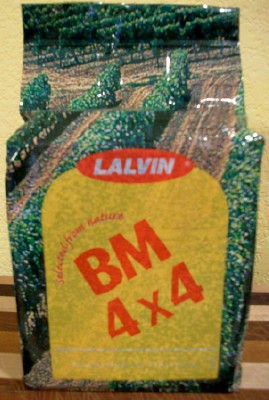 Given the rave reviews I've been hearing about BM4x4, I decided to obtain this yeast. I searched for a source of this yeast in small sachets but couldn't find one. Not being one to give up easily, I ended up ordering a 500 gram package. This ought to be enough to ferment about 500 gallons of wine, which means it'll expire long before I use it all. But so be it. I have my yeast. On another topic...a number of amateur Arizona wine makers and I are starting a wine making club of sorts. Our first informal meeting will be held in Tucson on February 13th. If you're interesting in participating, please contact me. My trellis construction project has been slowed considerably by a busy schedule at work (my day job). I must have this project completed before bud break in mid March. The one year old vines will (hopefully) start growing like weeds at that point. They'll need something to cling to. January 19 - As I write this, we are in the middle of our second storm for the week. Another big one is on the way. I wanted to post a link to an article on the benefits of rain that I originally shared last year, but found the link to be dead. Here's the Google cache of the article in question: While rain may have many benefits, it's not doing anything for my trellis project. My day job has been a major impediment as well. Look for pictures and construction details when trellis construction resumes. It will soon be time to prune my vines. That will also be the time to do some grafting as well. I have two varieties that just haven't worked out and need to be replaced. Look for an article on that topic in a few weeks. January 11 - Sorry for the lack of updates recently. My day job has been requiring my full and undivided attention, and what little time I've been able to spare has been devoted to working with my wines (racking mostly) rather than writing about them. I found the time this week to rack a Syrah made from pasteurized juice out of my Hungarian oak barrel. I took the opportunity to sample it, and I was very impressed. I've never been satisfied with the results when I've made wine from pasteurized juice like this, but oak aging may be just what's needed to turn it into great wine. The Chardonnay that I barrel fermented in this barrel is also tasting great. I think there are two things that wine makers can do to improve their results; 1) get better quality fruit or juice, and 2) age in oak and not just on oak (cubes, chips, etc.). I'm enjoying a glass of 2008 Pseudo Tuscan as I write this. It's a little early to be drinking a 2008 red wine, but at this point it's quite good. It's lighter in color and body than I was aiming for, but it seems to be a great "food wine". I'm looking forward to what it will become in another year or so. That article on Arizona's wine regions is back in progress, and I'll be posting notes on trellis construction in the weeks to come as I make progress on that front. Disease and Insect Control in the Sonoran Desert Prior to 2009 my spraying schedule was sporadic, but mostly sufficient. Aside from a recurring problem with Grape Leafhoppers, everything was kept in check. For 2009, thinking that my previous spraying approach was overkill, I decided to try a "light touch" and spray only when necessary to deal with a specific problem. This was a mistake. I had problems in 2009 with Powdery Mildew and Leaf Skeletonizers that I didn't have before. For 2010, I want to proceed with a comprehensive spraying program that will control all of these threats. Identify the Enemy The place to start when considering what and when to spray is the particular threats you are dealing with. There's no point in spraying something that is specific to a threat that your grapes will never see. Fortunately, here in the desert the list of potential threats is very short. Diseases like Black Rot and Downy Mildew cannot exist in the lower deserts; our temperatures are too high and the humidity is too low. Also, many of the insects that cause grape growers headaches in the eastern US haven't yet established a presence in central Arizona. The perennial fear for grape growers throughout most of the US is Pierces Disease. This disease is caused by a bacterium called Xylella fastidiosa, and is spread by insects like the Glassy-Winged Sharpshooter. These insects or "vectors" as they're called inadvertently carry the bacterium in their guts and spread it while feeding on sap from grape vines and certain other plants. The bacterium basically cuts off nutrient flow inside the plant, choking it to death from the inside. Once established in a region, the disease is virtually impossible to eliminate. The only option for most grape growers is to either replant with far less interesting varieties that are resistant or tolerant, or simply stop growing grapes altogether. Fortunately, at this point at least, this disease and its vectors are not widespread in Arizona. Glassy-winged Sharpshooters have been spotted in the Senoita wine region of Arizona, but aggressive management practices have kept their numbers in check. Some sources indicate that Pierce's disease has been found in the greater Phoenix area, but maps that show the spread of the disease across the country usually show a question mark over central Arizona. It seems that there may be a few pockets of the disease in the state, but it's not widespread. So the disease and pests that I need to control are Powdery Mildew, Grape Leafhoppers, and Leaf Skeletonizers. I do occasionally see damage to my vines caused by various unidentified insects, but the damage is not significant and if I'm spraying for Leafhoppers and Skelotonizers I'll probably control these others as well. The Chemicals and the Chemistry Next time you're at a party or in a crowd, start talking loudly about how you intend to spray chemicals in your yard or garden. Count the number of dramatic gasps that you hear, then listen for those mumbling under their breath about how environmentally insensitive you are. The word "chemicals" it seems, has become a dirty word. I suppose these concerns are not without merit, after all the widespread use of DDT devastated several species of birds, and the use of Agent Orange in Vietnam during the Vietnam War has been associated with all manner of health problems in both returning GI's and the Vietnamese people. I think these chemicals and their applications were the exception and not the rule. These chemicals and their side effects were clearly not understood, and their application was extreme. Don't get me wrong. I'd be thrilled if I could get by without spraying anything on my vines, and if I have to spray at all, I'd rather spray something that's naturally occurring and carries a low risk of collateral damage. Unfortunately it doesn't seem that effective organic equivalents exist for the control of all diseases and pests. But lets reconsider the notion of chemicals as a bad thing. After all, water is a chemical, but obviously it's not a problem. The organic insecticides and fungicides that are commonly used can all be classified as chemicals, but no one is suggesting they shouldn't be used. Even many synthetic agricultural chemicals actually carry very little risk of any problems, especially when applied according to the manufacturers recommendations. Remember, the biggest problems with DDT and Agent Orange were with their indiscriminate application and improper handling. Now I'm not suggesting that either of those should still be available. Clearly banning them was the right thing to do, but the lesson here is to follow the directions no matter what chemicals you're using. If you are going to spray anything, synthetic or organic, it's important to understand how it works and what risks are associated with it. Let's consider the chemicals that I'm familiar with and intend to use.
(1) Organic versions of Stylet Oil are available. (2) Although Pyrethrin is naturally occurring, insecticides may use synthetic versions known as Pyrethroids which don't qualify as organic. (3) 06/22/10 EDIT: It has come to my attention that the EPA has not approved Permethrin for use on grapes. It will be dropped from a future rewrite of this article. What Are They? Bordeaux powder is just copper sulfate. It's very effective at controlling blight, mildew, rots, and a variety of other fungal diseases. Neem oil is a vegetable oil pressed from the fruits and seeds of the evergreen Neem tree which is native to the Indian subcontinent. It's effective at repelling many types of insects by making the plant both unpalatable and an unpleasant place to reside. It also helps control mildews, rots, and fungal infections, probably in much the same way that stylet oil works. Stylet oil is simply food grade mineral oil. It controls mildews, rots, and fungal infections by breaking down cell walls. Stylet oil can be combined with some other pesticides or lime to extend it's capabilities. Do your research though before combining chemicals to make your own sprays. Some combinations could produce unexpected results. Pyrethrins are naturally occurring esters extracted from chrysanthemum flowers that kill insects when concentrations are high enough, and serve to repel insects when present in lower concentrations. Synthetic versions of pyrethrins are called pyrethroids. Permethrin is a common synthetic chemical that belongs to the pyrethroid class of synthetic chemicals. In other words, it's a synthetic version of the naturally occurring pyrethrin. Carbaryl, available commercially as "Sevin", is a chemical in the carbamate family. What this chemical does to insects is insidious. It's a cholinesterase inhibitor; I'll give you the short version of what that means... as neurons fire in the insect's brain, carbaryl prevents them from turning back off again, basically sending the little bugger into seizures or a full nervous breakdown followed by an untimely death. Imidacloprid is a synthetic chemical introduced in the 1980s that's analogous to nicotine, which itself is actually a naturally occurring insecticide. This chemical is generally applied to the soil or irrigation water rather than the plants themselves like most insecticides. The plant draws the chemical up through the roots and as the insects suck the juice out of the plants or eat the leaves they suffer a severe nervous breakdown not unlike that of carbaryl. While deadly for insects, this chemical is surprisingly benign for most animals. It's commonly used as a treatment for fleas and ticks on dogs, and in lab tests, rats have consumed large quantities of the stuff with no ill effects. You may be wondering why I would use chemicals that overlap in their capabilities. This is actually a good approach because over time insects can build up a tolerance or immunity to any particular insecticide. If you are employing a variety of chemicals this is less of an issue. Collateral Damage and Other Issues The use of some chemicals has unintended consequences. Residual copper sulfate on grapes can cause the production of H2S during fermentation. Both carbaryl and imidacloprid have been associated with colony collapse disorder, the widespread and poorly understood loss of honey bees throughout North America. Fortunately for us, bees have little interest in grape vines, so the use of these chemicals in vineyards carries little risk for the bees. Still though, you shouldn't apply either of these chemicals if bees are active in the area. Another area of concern is marine life. Some aquatic animals (especially crustaceans) are sensitive to both carbaryl and imidacloprid since their nervous systems are similar to those of insects. Care should be taken not to apply either near sensitive marine environments. My Spraying Schedule Although subject to change, at this point I'm leaning towards....
One word of caution about the application of these chemicals and our heat. It's generally inadvisable to apply most chemicals during the heat of summer. We start hitting 100 degrees about mid-May. At that time you should start spraying as late in the evening as possible. Later in the summer as temps exceed 110 mid-day, you should consider discontinuing spraying since night time temps will be too hot for the safe application of many chemicals. Spraying in the heat stresses vines and causes more harm than good. Final Thoughts This seems like a good place for a disclaimer... I'm not a chemist nor do I play one on TV, so don't use this article as a substitute for more authoritative sources. No matter what products you're using, make sure to read and understand the labels. It's also a good idea to study up on your chosen chemicals; there are some excellent resources on line for doing just that. Remember too that organic chemicals are still chemicals and their use may carry certain risks. January 1 - I placed the 2009 Pseudo Tuscan under refrigeration yesterday. One of my reasons for cold stabilizing this batch is to help settle the fluffy lees produced by the addition of Lysocid W. A thin layer of tartaric crystals should help hold down the lees during the next racking, and cold stabilization isn't a bad idea in any case. I've had a Syrah made from pasteurized juice aging in my Hungarian oak barrel for about two months now. I tasted a sample yesterday and was very satisfied with it. Barrel aging makes a huge difference. I'm anxious to see how it might improve wine from my own grapes. I started buying supplies yesterday for all of the trellises I need to build. Everything needs to be done by mid-March, by which time the vines will come out of dormancy and start growing like weeds. I'll post notes and pictures on my approach to building trellises, but as I've said before, I would never claim my approach is the "right approach". That article on Arizona's Wine Regions and Terroir remains on hold while I wait for assistance with some graphics. | |||||||||||||||||||||||||||||||
| 2009 Archive |
| Home | About Us | Wines | Vineyards | Blog |
